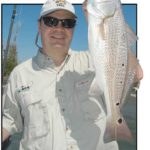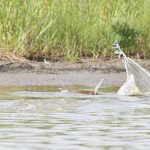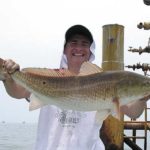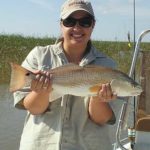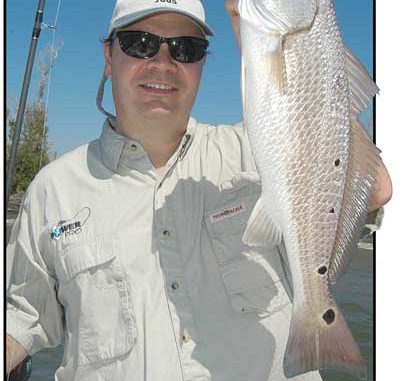
Cooling temperatures mean Venice’s redfish population goes absolutely bananas.
Few things in the Louisiana coastal fishing arena can match the fall and winter speckled trout run. The problem lies in the timing of such an event. Myriad factors go into exactly when the fish turn on, whether it’s catching them in the passes during years of a low Mississippi River or in the surrounding bays when the Big Muddy swells. Fortunately for anglers fishing the lower delta, redfish are not nearly as high maintenance. And they’re available to fishermen in any variety of ways, from watching a bobber sink along cane-lined shorelines to deep cranking downriver jetties to tossing offerings in front of waking skinny-water fish.
The storms of last summer ruined innumerable ponds and flats and the spectacular visuals involved in seeing redfish in water clean enough to count the spots before casting. But it hardly put a damper in being able to put fish in the boat, as was evidenced by sight of the cleaning table at Venice Marina next to the 2008 Plaquemines Parish Redfish Series weigh-in. Well before the tournament’s deadline, limit after limit was steadily tossed onto the cleaning table and carved into tasty fillets.
The spectacle was interrupted briefly by a load of tuna anglers who had taken advantage of a relatively placid early October Friday night to harvest a nice catch of yellowfins, but for two hours and change, boat after boat — both guides and otherwise — pulled up to the dock and off-loaded redfish in five-fish increments.
“It’s a special time of year right now, even while a lot of us are waiting for the trout to turn on,” said Capt. Shane Mayfield of Adventure South Guide Service. “The redfish numbers are just incredible out there right now.”
The affable delta vet was winding down under the pavilion at Venice Marina, watching the weigh-in with a gang of fellow guides, who were busy dishing out good-natured barbs to friends competing in the tournament. While competitors shook their heads in amazement at the shared stories among fellow participants, Mayfield just smiled and nodded, knowing what a blessing the redfish population was to his guide business.
“It’s always been the same thing down here,” he said. “People from around here want to catch trout, but the guys from elsewhere want a big ol’ red to pull on. The great thing about down here is that there are so many different way to catch them. Most people like to see a redfish in real clear water and cast to them and watch them eat it. But there are a lot more people who aren’t ready for that kind of technique.
“So, we’ve always got different ways of catching fish for different people. Luckily, the Venice area gives us lots of options. And that’s why even when the trout haven’t shown up in the typical fall spots, the redfish can keep everybody happy.”
Capt. Brandon Carter of Reel Shot Guide Service thinks similarly of the early fall redfishing, when temperatures — air and water — are coming off the scorching summertime levels, and options abound in putting fish in the boat.
“You’re always waiting for the trout to turn on, because that’s what we live for down here,” he said. “But the fall redfishing is a blast. There’s just so many different options on the table.”
Several years ago, Carter and a few of his fortunate kin were kind enough to allow me to tag along on a family reunion of sorts. We had all kinds of ideas of catching redfish on a variety of baits, from big-bladed spinnerbaits to shallow-running crankbaits.
But from the first cast to the last, the only thing the 50 or so redfish would eat on that chilly day in a decidedly milky East Bay was the simplest of rigs — a ¼-ounce jighead with a soft plastic of our choice a foot and a half under a cork.
While I marveled at the fish’s refusals of the heavily vibrating spinnerbait and the intense chatter of the crankbait and its ball-bearing rattles, Carter explained that this was nothing new.
“Sometimes the fish has just got to be called in and given enough time to find the bait,” he said. “I bet they’re attracted to those other baits, but by the time they’ve had time to investigate, the bait’s probably being picked up by us for another cast.”
Carter says the same theory can be applied to fishing cork rigs up against the miles of roseau cane-lined shorelines. Though the water is typically clearer in these locales — especially when the tide falls and allows stained water to be filtered through the canes — and reaction baits are given a chance to be more effective, cork rigs are almost always the preferred technique. And not just because they’re the most obvious of strike indicators.
“The cane banks — especially the really productive points — have eroded so much that fishing with a cork is really the only way to go for most people,” Carter said. “The cane stubble extends a good ways off the bank, and it can become a virtual jighead graveyard for almost anybody. Besides that, the corks just do a great job of calling in the fish, not to mention that people just like to watch that cork sink.”
Besides the cork-and-jig method, Mayfield says crankbaits of all different depths can draw strikes from reds, and they can do so in the most unlikeliest of places.
“Especially when the river is low, throwing a super shallow-running crankbait up onto flats is really productive,” he said. “We don’t use them a whole lot on charters because I like to stay away from treble hooks and the mess they can make, but they provide a lot of vibration and a lot of noise that calls the fish from a good distance.
“Another thing the really shallow-running models do is provide a wake. So in addition to pushing a lot a water because they’re generally short and squat baits, they create a disturbance on the surface.”
Redfish often congregate this time of year near cuts off of main passes where ponds and areas of broken marsh drain. Falling tides provide ideal ambush points for reds looking to cash in on easy meals. Jigs being cast onto the adjoining flats and stair-stepped down the drop-offs are good ways to cash in on these fish. Flounder are also tasty byproducts in early fall.
Also in play this time of year are big-water areas such as the Head of Passes and Cubit’s Gap. While this is another technique that Mayfield and most other guides tend to avoid due to the degree of difficulty involved, he indicated that if anglers are successful in getting baits to the bottom in the swirling currents, tremendous benefits await.
“The corners of the main passes can be really good if you can get it down to them,” Mayfield said. “You almost have to Carolina rig it with a heavy egg sinker sometimes, but when some cool weather comes through, the reds will pull off into about 20 feet of water or even more.”
Using one’s electronics can be important in finding these fish. Fishing near the mouth of Joseph’s Bayou just east of Southwest Pass, Mayfield recalled a recent trip when the redfish had pretty much disappeared from the landscape. With a nice mess of trout in the box, the customers clamored for a few rounds with the bronze brutes.
“It was right in the middle of the bayou where we started marking fish,” he said. “I got a little bit upcurrent, we dropped the jigs straight down and it wasn’t two seconds before everybody was bowed up with 25-, 26-inch redfish.
“That’s what makes Venice a cool dynamic. The fish disappear for a few days and just show up in a random place like that. Anybody could have found them by paying attention to their electronics.”
On the inside of the rocks separating the river and the Gulf are wing dams. Deep jigging these structures is an outstanding way to put reds in the boat, according to Mayfield.
“The thing with those dams is that they simply create a current break in the river,” he said. “It’s an easy place for any predator fish to get out of the flow and take advantage of bait being swept by and getting swept into an eddy where they’re disoriented.
“The thing you need to do there — like anything in fishing — is cast upcurrent and work the bait back to the boat. It’s a pain sometimes in keeping in contact with the bait when the current is really moving, but you’ve got to imaging the fish’s head looking into the current for his meal coming at him.”
Bigger, deeper-diving crankbaits are outstanding alternatives to jigs when fishing the rocks far downriver in that they generally can be kept off the rocks by casting at the right angle.
“On the west side, there used to be a good 40, even 50 feet of rocks sloping off on a grade,” Mayfield said. “Now, it seems like it’s about half that. The fishing is still just as good down there, but there’s just not as much structure to contend with, and I guess you could say it congregated the fish more.
“You can throw those expensive crankbaits a little easier now. Just experiment with the angles until you find where they’re holding on the rocks. Usually where you get one hit is where you’ll get a bunch of others.
“One more thing with these bass crankbaits — if they don’t come with heavy-duty hooks, don’t even bother throwing them without changing the hooks. You’ll just be wasting your time. You might not lose a fish on them, but the first or second fish you unhook will mangle the hooks so bad they’ll be unusable.”
Though he says you should always work the river from the bottom up, corks are not at all out of the question.
“Nine times out of 10, they’ll be on the bottom, but you never know what kind of bait schools are moving through that could position them just under the surface, even in 20 feet of water,” he said.
For more information, call Capt. Brandon Carter at (985) 969-0810 or Capt. Shane Mayfield at (504) 382-2711.
